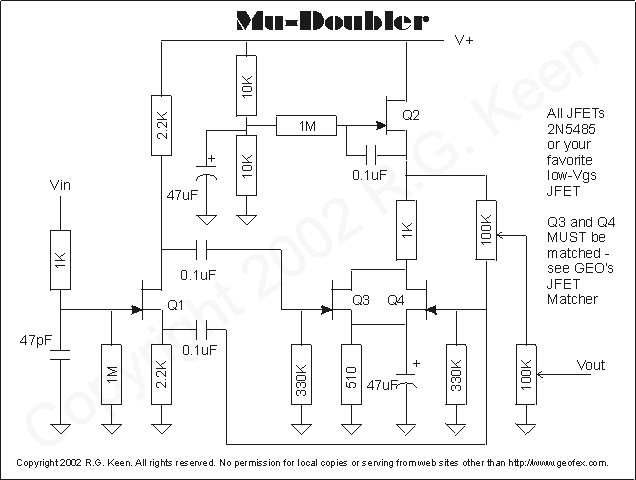| The ongoing saga of the MOS Doubler keeps on
rolling.
I decided that what I really needed was more gain on the second order distortion products, and for that I had to give up the variable base signal. That led me full circle back to the dry/octave blend I started the MOS Doubler with. But it's working out - there are some nice kinks in this one. Here's the circuit. The phase inverter is again a single JFET. This works well enough and is much simpler than a dual opamp version as I've done in several earlier incarnations. The signal enters through the 1K resistor and any RF over 3MHz is shunted to ground by the 47pF cap. The 1M resistor at the gate of the first JFET Q1 holds the gate at ground. The conduction of Q1's channel biases Q1 by raising the voltage on its source by the amount of current flowing through R3. I used 2N5485's, as I had these and the Vgsoff is about right. You can adapt this to many JFETs by changing the value of R3 to get the source voltage to between 1.5 and 3V, and then putting the same value in for the drain resistor of Q1so it's still a phase splitter. In my circuit, 2.2K worked fine. Oddly enough, MOSFETs work fine in this circuit and give even more gain. A BS170 or 2N7000 can be subbed into every single transistor position. The only gotcha is that you then have to take the gate resistors to a positive bias source instead of to ground. See my article on designing MOS Boosters for some detailed info on biasing MOSFETs. The signals at the source and drain of Q1 are equal magnitude, but opposite phase, as befits a phase inverter.
The two phase-opposite signals are fed through capacitors to the opposing gates of the signal canceling pair, Q3 and Q4. For the best octave results, Q2 and Q3 must be matched. Match Q3 and Q4 as closely as you reasonably can with the JFET Matching Fixture. They needn't be perfect, but the better you do here, the more predictably it will operate. The signal canceling pair are biased by the 510 ohm resistor. You should see something lik 1.5V to 1.9V at the joined sources of Q3 and Q4. The new wrinkle with the Mu-Doubler is that I have used an active load in the drain circuit of the doubling stage. I used the SRPP circuit to give me large gain on the distortion products while at the same time providing a low output impedance to drive following stages. With this setup, I did not need any following buffers. Likewise, taking the dry signal from the source of Q1, I had a low impedance output to feed the output mixer. As in the JFET Doubler, the 100K from the gate of Q4 to the source of Q2 is an octave balance control. When it's full up, the signal from Q2's source is fed to the output volume control, and you get mostly pure octave. There is some dry signal contamination, but in practice this is not an impediment. Twist the knob the other way, and the dry signal from the source of Q1 is feeding the 100K volume control and you get primarily dry signal, with a tiny bit of octave contamination. With well matched Q2 and Q3, this baby screams out an octave and lets you blend between the dry signal in to your heart's content. Again, you have to find JFETs with a gate sensitivity suitable to the circuit. Some JFETs have Vgsoff of 7 to 10 Volts, and these will not work here. Some suitable JFETs are 2N5292, 2N5485, 2N5486, J201, 2N5457. Others will work, especially if you select for low Vgsoff. The GEO JFET matcher will read out the Vgs voltage directly for a suitable JFET, and you can just pick two for Q3 and Q4 that have the same voltage. Get JFETs with Vgs on the matcher of 3V or less. 1 to 2 volts is ideal. Matching is necessary for this one to work right. This circuit on its own is usable to produce an almost-parody of tube sound. It can make a lot of second harmonic, and so you can get an exaggerated soft distortion. It is not a high distortion widget itself. You may want to combine it with other stuff to tailor your sound. As always, comments are welcome! R.G. 4/21/02 |
